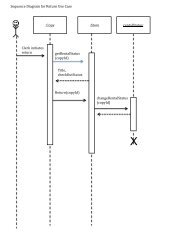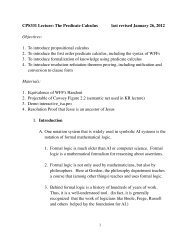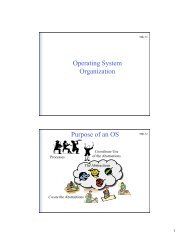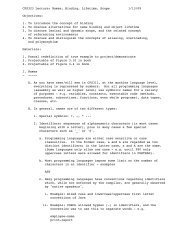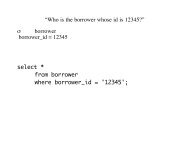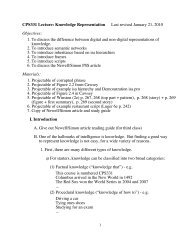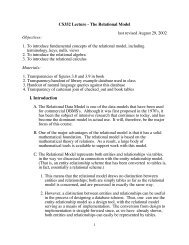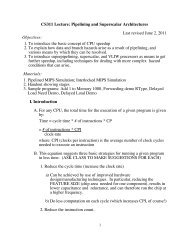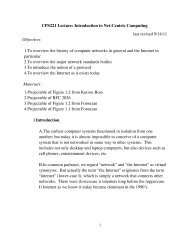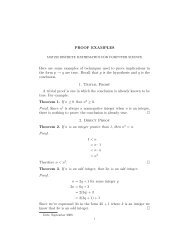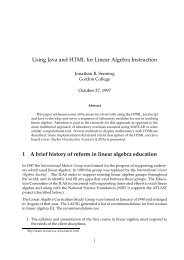Class Diagrams in UML
Class Diagrams in UML
Class Diagrams in UML
Create successful ePaper yourself
Turn your PDF publications into a flip-book with our unique Google optimized e-Paper software.
CPS211 Lecture: <strong>Class</strong> <strong>Diagrams</strong> <strong>in</strong> <strong>UML</strong><br />
Last revised July 24, 2008<br />
Objectives:<br />
1. To <strong>in</strong>troduce <strong>UML</strong> <strong>Class</strong> <strong>Diagrams</strong><br />
2. To expla<strong>in</strong> the association relationship between objects, adornments possible on<br />
such relationships, and ways of us<strong>in</strong>g these relationships<br />
3. To <strong>in</strong>troduce aggregation and composition associations<br />
4. To <strong>in</strong>troduce the dependency relationship between classes<br />
5. To review the <strong>in</strong>heritance relationship between classes, and consider how to use<br />
<strong>in</strong>heritance <strong>in</strong> design<br />
6. To <strong>in</strong>troduce the realization relationship between a class and an <strong>in</strong>terface<br />
Materials:<br />
1. Handout of class diagram for ATM Example<br />
2. Handout of class/object diagram symbols<br />
I. Introduction<br />
A. As we po<strong>in</strong>ted out at the start of the course, there are many different<br />
processes that can be followed <strong>in</strong> software development (e.g. waterfall life<br />
cycle, RUP, etc).<br />
B. Regardless of what process is followed, however, certa<strong>in</strong> tasks will need to<br />
be done as part of the development process per se - whether all at once,<br />
iteratively, or <strong>in</strong>crementally. In fact, activities like these will be part of<br />
any situation <strong>in</strong> which one uses his/her professional skills to help solve<br />
someone else’s problem - not just when creat<strong>in</strong>g software or even <strong>in</strong> a<br />
computer field.<br />
1. Establish<strong>in</strong>g Requirements: The goal of this is to spell out what<br />
constitutes a satisfactory solution to the problem.<br />
2. Analysis. The goal of this is to understand the problem. The key<br />
question is “What?”.<br />
3. Design. The goal of this is to develop the overall structure of a solution<br />
to the problem <strong>in</strong> terms of <strong>in</strong>dividual, buildable components and their<br />
relationships to one another. The key question is “How?”.<br />
4. Implementation. The goal of this task is to actually build the system<br />
as designed.<br />
5. Installation / Ma<strong>in</strong>tenance / Retirement<br />
1
All of these must be done <strong>in</strong> a context of commitment to Quality<br />
Assurance - ensur<strong>in</strong>g that the <strong>in</strong>dividual components and the system<br />
as a whole do what they are supposed to do (which may <strong>in</strong>volve<br />
identify<strong>in</strong>g their shortcom<strong>in</strong>gs and fix<strong>in</strong>g them.)<br />
C. Last class dealt with <strong>in</strong>itial identification of the key classes compris<strong>in</strong>g a<br />
system - an analysis task. At this po<strong>in</strong>t, we beg<strong>in</strong> to construct a class<br />
diagram, which cont<strong>in</strong>ues to be ref<strong>in</strong>ed as system development proceeds.<br />
1. In the spirit of “seamless development” that characterizes OO, the<br />
<strong>in</strong>itial development of a class diagram is an analysis task, which is<br />
ref<strong>in</strong>ed as part of design.<br />
2. Ultimately, the complete class diagram for a system will conta<strong>in</strong> three<br />
general types of classes:<br />
a) Dur<strong>in</strong>g analysis, the classes discovered will typically be entity classes<br />
which represent “th<strong>in</strong>gs” <strong>in</strong> the doma<strong>in</strong> that the system must work<br />
with to fulfill its requirements.<br />
(1) The book suggests two general approaches to discover<strong>in</strong>g these<br />
classes<br />
(a) One can consider what objects are <strong>in</strong>volved <strong>in</strong> realiz<strong>in</strong>g a<br />
given use case.<br />
Quick check question b (p. 118)<br />
When all the objects appear<strong>in</strong>g <strong>in</strong> each collaboration are<br />
comb<strong>in</strong>ed, the result will be an overall class diagram for the<br />
system. (Note: there will typically be objects that appear <strong>in</strong><br />
more than one collaboration)<br />
(b) One can seek to develop a model of the general doma<strong>in</strong><br />
(c) Either approach should result <strong>in</strong> the same overall model<br />
(2) The book suggests several broad categories to look for<br />
Quick-Check question d (p 119)<br />
(a) People<br />
(b) Organizations<br />
(c) Physical th<strong>in</strong>gs<br />
2
(d) Conceptual th<strong>in</strong>gs<br />
Examples from Wheels<br />
ASK<br />
Customers<br />
Bicycles<br />
The hir<strong>in</strong>g of a bicycle<br />
b) As one moves <strong>in</strong>to the design stage, one typically beg<strong>in</strong>s deal<strong>in</strong>g<br />
with the other types of classes<br />
Quick check question a (p 118)<br />
I prefer to use a slightly different way to categorize these<br />
(1) Boundary classes whose objects serve as means by which actors<br />
<strong>in</strong>teract with the system - i.e. conceptually they sit on the<br />
boundary drawn dur<strong>in</strong>g use case analysis.<br />
(a) These may <strong>in</strong>clude one or more GUIs<br />
(b) These may <strong>in</strong>clude <strong>in</strong>terfaces to other systems via a network<br />
(2) Controller classes whose objects are responsible for controll<strong>in</strong>g<br />
the operation of the system. Typically each use case will be<br />
assigned to a controller object - though one controller may be<br />
responsible for multiple use cases.<br />
3. Ultimately, the class diagram will conta<strong>in</strong> quite a bit of <strong>in</strong>formation<br />
a) The classes themselves<br />
b) The attributes of each class<br />
c) The operations of each class<br />
d) Relationships between classes<br />
4. The book suggests an overall process for develop<strong>in</strong>g a class diagram<br />
Quick check question c (p. 118)<br />
3
D. For the next few sessions, we want to look at the <strong>UML</strong> <strong>Class</strong> Diagram,<br />
which can represent a lot of <strong>in</strong>formation. In particular, we will focus on<br />
various relationships between classes.<br />
1. What these mean<br />
2. How they are represented<br />
E. At the outset, we note that there are two different sorts of relationship,<br />
that we handle similarly but need to keep dist<strong>in</strong>ct <strong>in</strong> our th<strong>in</strong>k<strong>in</strong>g.<br />
1. There are relationships between <strong>in</strong>dividual objects. Such a relationship<br />
describes how a particular object of one class relates to a particular<br />
object of another class.<br />
a) Among humans, the relationship known as marriage is such a<br />
relationship. It relates one <strong>in</strong>dividual to another specific <strong>in</strong>dividual.<br />
You may know many married people, but each has a different<br />
spouse.<br />
b) In the OO world, the l<strong>in</strong>k along which a message is sent from an<br />
object to one of its collaborators is such a relationship - a particular<br />
sender sends a message to a particular receiver. (That is, the<br />
Collaborators column of a CRC card is document<strong>in</strong>g associations.)<br />
c) In this case, then, each <strong>in</strong>dividual object participates <strong>in</strong> the<br />
relationship (or doesn’t participate <strong>in</strong> the relationship, as the case<br />
may be) with its own particular partner or partners.<br />
d) Where th<strong>in</strong>gs get a bit confus<strong>in</strong>g is that when we identify an<br />
<strong>in</strong>dividual relationship between objects, we are also identify<strong>in</strong>g a<br />
relationship between the correspond<strong>in</strong>g classes. The fact that an<br />
object of class Book is related to one or more objects of class<br />
Author implies that there is a relationship between the classes Book<br />
and Author such that a member of the one class can participate <strong>in</strong><br />
this relationship with a member of the other class.<br />
2. There are relationships between classes. Such a relationship describes<br />
how one whole class of objects is related to another class.<br />
a) Among humans, the fact that all CS majors are also students is such<br />
a relationship.<br />
b) In the OO world, generalization, or <strong>in</strong>heritance, is such a<br />
relationship.<br />
4
c) In the case of a class relationship, all the objects that belong to a<br />
given class participate <strong>in</strong> the relationship <strong>in</strong> the same way.<br />
3. In draw<strong>in</strong>g a class diagram, we can depict all k<strong>in</strong>ds of relationships -<br />
even those that are actually relationships between <strong>in</strong>dividual objects.<br />
(Indeed, the class diagram is the more frequently used type of diagram<br />
<strong>in</strong> <strong>UML</strong> <strong>in</strong> general.).<br />
F. In this series of lectures and the next, we will discuss four k<strong>in</strong>ds of<br />
relationships (three of which are exemplified <strong>in</strong> the ATM class diagram<br />
handed out.). We will consider object relationships (the first k<strong>in</strong>d) first, and<br />
class relationships (the next three) later.<br />
HANDOUT: Diagram symbols<br />
1. Association - a relationship between objects.<br />
EXAMPLES FROM CLASS DIAGRAM; SYMBOLS HANDOUT<br />
a) In a class diagram, this k<strong>in</strong>d of relationship is represented by a solid<br />
l<strong>in</strong>e, possibly with a pla<strong>in</strong> arrow head on one end. There can<br />
multiplicities at both ends.<br />
When there is an association between two classes, it means that an<br />
object belong<strong>in</strong>g to one class can be related <strong>in</strong> this way to an object<br />
belong<strong>in</strong>g to another class.<br />
Liv<strong>in</strong>gCreature<br />
Human<br />
Master<br />
Pet<br />
1<br />
*<br />
b) There are two special k<strong>in</strong>ds of associations, which we have already<br />
looked at briefly, and will say more about later<br />
5
(1) Aggregation - an association represent<strong>in</strong>g a whole-part<br />
relationship<br />
(2) Composition - a strong form of aggregation<br />
2. Dependency - a relationship between classes. In a <strong>UML</strong> diagram, this<br />
is represented by a dashed l<strong>in</strong>e with an arrowhead on one end.<br />
EXAMPLES FROM DIAGRAM; SYMBOLS HANDOUT<br />
3. Generalization (<strong>in</strong>heritance) - a relationship between classes. In a <strong>UML</strong><br />
diagram, this is represented by a solid l<strong>in</strong>e with a triangle on one end.<br />
EXAMPLES FROM DIAGRAM; SYMBOLS HANDOUT<br />
4. Realization - a relationship between a class and an <strong>in</strong>terface. In a<br />
<strong>UML</strong> diagram, this is represented by a dashed l<strong>in</strong>e with a triangle on<br />
one end. (Note that the symbol is similar to that for generalization,<br />
because realization is similar to <strong>in</strong>heritance.)<br />
NO EXAMPLES IN CLASS DIAGRAM - WILL DISCUSS BELOW;<br />
SYMBOLS HANDOUT<br />
6
II. Relationships Between Objects: Associations<br />
A. Relationships between <strong>in</strong>dividual objects are called associations <strong>in</strong> <strong>UML</strong>.<br />
They are depicted by a solid l<strong>in</strong>e on a class diagram, or an object diagram.<br />
B. Technically, the fact that an object of class A can be associated with an<br />
object of class B is called an association and the correspond<strong>in</strong>g connection<br />
between a specific object of class A and a specific object of class B is called<br />
a l<strong>in</strong>k. That is, an association is conceptually a set of l<strong>in</strong>ks.<br />
C. In the simplest case, an association may simply be drawn as l<strong>in</strong>e. But<br />
often, the l<strong>in</strong>e has one or more adornments that provide further<br />
<strong>in</strong>formation about the association. [ Note: for clarity, as we talk about<br />
each type of adornment we will omit others that might otherwise belong<br />
<strong>in</strong> the diagram ]<br />
1. Navigability (directionality):<br />
a) Ord<strong>in</strong>arily, associations are conceived of as be<strong>in</strong>g bidirectional - e.g.<br />
<strong>in</strong> the diagram show<strong>in</strong>g the association between a Book and its<br />
Author(s), we probably <strong>in</strong>tend for it to be possible to go from a<br />
Book object to its Author object(s), and likewise to go from an<br />
Author object to the Book(s) it is the author of.<br />
b) Sometimes, though, an association is conceptually unidirectional -<br />
e.g. if were to try to depict the relationship between a Server<br />
system and a Client system that uses it, we might draw it this way:<br />
Server<br />
Client<br />
The arrow says that the Client must know about the Server, but the<br />
Server does not need to know about the Client (except briefly,<br />
dur<strong>in</strong>g the time it is respond<strong>in</strong>g to a message received from the<br />
Client.)<br />
7
c) Why would we want to identify an association as be<strong>in</strong>g<br />
unidirectional where this is appropriate is? The presence of an<br />
association <strong>in</strong> the class diagram implies that the implementation will<br />
need to ma<strong>in</strong>ta<strong>in</strong> <strong>in</strong>formation about this association. Keep<strong>in</strong>g<br />
<strong>in</strong>formation about a bidirectional association means that both objects<br />
will have to ma<strong>in</strong>ta<strong>in</strong> <strong>in</strong>formation about the association. If this is not<br />
necessary, ma<strong>in</strong>ta<strong>in</strong><strong>in</strong>g the association <strong>in</strong> only one direction will<br />
simplify the implementation.<br />
2. Multiplicity: Some associations are conceptually one to one - one object<br />
of a given type relates to one object of another type. Others allow one<br />
object of a given type to be related to many objects of another type.<br />
Here are some different situations that often arise, and the<br />
correspond<strong>in</strong>g <strong>UML</strong> representation:<br />
a) One-to-one. Example: marriage (at least as <strong>in</strong>tended!)<br />
Husband<br />
1 1<br />
Wife<br />
b) One-to-many: Example: the relationship between a book and the<br />
<strong>in</strong>dividual chapters that are part of it.<br />
Book<br />
1 *<br />
Chapter<br />
c) Many-to-many: Example: students and courses<br />
Course<br />
Student<br />
* *<br />
d) Often, the multiplicities will be expressed as ranges, rather than as<br />
simple values<br />
(1) Example: the marriage relationship above was shown as 1 to 1<br />
between the classes Man and Woman. If it were shown as a<br />
association between class Male and Female, the multiplicities<br />
would need to be expressed as ranges. (One cannot be a<br />
Husband or Wife without be<strong>in</strong>g married, but one can be a Male<br />
or Female without be<strong>in</strong>g married, so either can be associated<br />
wiht 0 or 1 of the other!)<br />
8
Male<br />
0..1 0..1<br />
Female<br />
(2) Example: a person has exactly two birth parents. A parent has<br />
at least one child, but can have any number:<br />
Parent<br />
2 1..*<br />
Child<br />
(3) Example: the annual volleyball competition between the Math<br />
and CS w<strong>in</strong>gs of our department <strong>in</strong>volves up to 5 games. In<br />
each game, at least 12 but no more than 30 students can<br />
participate.<br />
Game<br />
0..5 12..30<br />
Player<br />
(This one’s a bit contrived to illustrate a po<strong>in</strong>t, I admit :-).<br />
(4) The symbol * we have previously used means “0 or more” -<br />
hence it is equivalent to 0..*<br />
e) If the lower limit on the multiplicity of a certa<strong>in</strong> relationship is 0, we<br />
say that the relationship is optional. If the lower limit is greater<br />
than 0, we say that the relationship is mandatory. Note that the<br />
same relationship may be optional <strong>in</strong> one direction, and mandatory<br />
<strong>in</strong> the other.<br />
(1) Example: the relationship between a customer and the orders<br />
he/she has placed with a company. Assum<strong>in</strong>g a person can<br />
register as a customer before plac<strong>in</strong>g an order, we have the<br />
follow<strong>in</strong>g scenario:<br />
Customer<br />
1 *<br />
Order<br />
9
The relationship from an order to a customer is mandatory -<br />
every order must be associated with a customer. The<br />
relationship from customers to orders is optional - a customer<br />
does not need to have any orders.<br />
(2) It’s certa<strong>in</strong>ly possible to have a relationship that’s optional both<br />
ways - e.g. the relationship between a library patron and books.<br />
he/she currently has checked out. A patron does not have to<br />
have any books checked out at a given time, nor does any<br />
particular book have to be checked out at a given time.<br />
Patron<br />
0..1 *<br />
Book<br />
(3) Recall that the notation “*” is short for “0..*”, and so stands for<br />
a relationship that is <strong>in</strong>herently optional. If the relationship is<br />
mandatory, but of unlimited multiplicity, we must use the form<br />
“1..*”.<br />
(4) Also note that some writers use the notation “n” <strong>in</strong>stead of * <strong>in</strong><br />
a range - so * (= 0..*) is written as “0..n” and 1..* is written as<br />
“1..n”.<br />
f) Note: Often <strong>in</strong> the literature the term “card<strong>in</strong>ality” is used for what<br />
we have called “multiplicity”. The authors of the <strong>UML</strong> reference<br />
po<strong>in</strong>t out that - technically - card<strong>in</strong>ality refers to the properties of a<br />
particular <strong>in</strong>stance of an association, while multiplicity refers to the<br />
overall properties of the association itself.<br />
E.g. if there are 22 students enrolled <strong>in</strong> a given course, then the<br />
card<strong>in</strong>ality of the relationship between the object represent<strong>in</strong>g that<br />
course and the students <strong>in</strong> it is 22; but the multiplicity of the<br />
relationship between the class Course and the class Students might<br />
be, say 0..200 - assum<strong>in</strong>g a course might have no students <strong>in</strong> it but<br />
cannot have more than 200.<br />
We’ll use the term “multiplicity” here - but understand that you<br />
will often see the term “card<strong>in</strong>ality” used to mean the same th<strong>in</strong>g<br />
3. Name: Often, the mean<strong>in</strong>g of the association is implicit <strong>in</strong> the classes<br />
that are related, but sometimes an association will be given a name to<br />
make its mean<strong>in</strong>g explicit.<br />
a) EXAMPLE:<br />
10
Course<br />
EnrolledIn<br />
* *<br />
Student<br />
(Note the arrow on the name, which <strong>in</strong>dicates how it is to be read:<br />
“a student is enrolled <strong>in</strong> a course”. It has noth<strong>in</strong>g to do with<br />
navigability of the association itself, which is bidirectional <strong>in</strong> this<br />
case.)<br />
b) Giv<strong>in</strong>g a name to an association is especially important <strong>in</strong> cases<br />
where there are two different relationships between the same pair of<br />
classes.<br />
EXAMPLE<br />
Department<br />
1..*<br />
*<br />
MajorsIn<br />
M<strong>in</strong>orsIn<br />
*<br />
*<br />
Student<br />
(Note that a student must have at least one major, but can have<br />
zero or more m<strong>in</strong>ors)<br />
c) Note that association names typically beg<strong>in</strong> with an upper-case<br />
letter, denot<strong>in</strong>g that they are “class like”. In fact, <strong>in</strong> some cases an<br />
association may need to be represented by an Association <strong>Class</strong>.<br />
This is particularly true when there are one or more attributes that<br />
are attributes of the association itself, rather than of the participat<strong>in</strong>g<br />
object.<br />
Example call<strong>in</strong>g for an association class - the association between a<br />
student and a course, which has a grade attribute that is a property<br />
of the association - not of the student (who has <strong>in</strong>dividual grades for<br />
each course) or of the course (s<strong>in</strong>ce there are <strong>in</strong>dividual grades for<br />
each student.)<br />
EnrolledIn<br />
grade: Grade<br />
Course<br />
* *<br />
Student<br />
(Note the use of the three sets of l<strong>in</strong>es <strong>in</strong> the box represent<strong>in</strong>g the<br />
association class, to make it crystal clear that this is a class.)<br />
11
4. Qualified Association: Sometimes, a given object can be associated with<br />
many objects of some other class, but there is some qualifier such that,<br />
for any given value of the qualifier, the object is associated with at most<br />
one other object.<br />
EXAMPLE:<br />
A college is associated with many students; but for any given student<br />
id, there is at most one associated student (or possibly none). We say<br />
that the association between the college and students is a qualified<br />
association, with student id as the qualifier. This can be depicted as<br />
follows:<br />
College<br />
id<br />
1<br />
0..1<br />
Student<br />
(Note how the effect of the qualification is to reduce the multiplicity<br />
from 1 : n to 1 : 0..1 - for any given id value, there is at most one<br />
match<strong>in</strong>g student)<br />
5. Role: Often, the specific roles played by the two objects <strong>in</strong> a<br />
relationship is implicit <strong>in</strong> the classes to which they belong; but<br />
sometimes the roles are named explicitly: This is especially necessary<br />
<strong>in</strong> cases where an association connects objects of the same class to each<br />
other.<br />
EXAMPLE:<br />
supervisor<br />
Supervises<br />
1 *<br />
Employee<br />
supervisee<br />
Note: Care must be used <strong>in</strong> draw<strong>in</strong>g a diagram to dist<strong>in</strong>guish between<br />
the name of an association and role names. The latter should be drawn<br />
near the end of the association l<strong>in</strong>e; the former far enough from the<br />
ends to be clear that it is not a role.<br />
6. Aggregation/Composition: Sometimes, an association is stronger than<br />
an ord<strong>in</strong>ary association, <strong>in</strong> that one of the objects can be thought of as<br />
be<strong>in</strong>g part of the other - i.e. the relationship is one between a whole<br />
and its constituent parts. We call such an association aggregation.<br />
12
a) Aggregation is appropriate when we can mean<strong>in</strong>gfully use the<br />
phrase “is a part of” to describe the relationship between the part<br />
and the whole, or “has a” to describe the relationship between the<br />
whole and the part.<br />
EXAMPLES:<br />
(1) In the ATM system, the CardReader, CustomerConsole, etc.<br />
objects are parts of the ATM object. This is a stronger<br />
connection than most of the examples of associations we have<br />
considered thus far.<br />
(2) The relationship between a course and its students might also be<br />
thought of as an aggregation, though this is perhaps a bit more<br />
debatable. (Perhaps most appropriate <strong>in</strong> a situation were we are<br />
model<strong>in</strong>g student registrations <strong>in</strong> a course.)<br />
b) Aggregation is denoted <strong>in</strong> a <strong>UML</strong> diagram by putt<strong>in</strong>g a diamond on<br />
the “whole” part of the relation.<br />
c) Aggregation actually comes <strong>in</strong> two forms: simple aggregation, and a<br />
stronger form, called composition.<br />
(1) Composition has the additional characteristic that the “part” has<br />
no existence <strong>in</strong>dependent of the “whole”. This leads to two<br />
additional characteristics:<br />
(a) Each “part” can belong to only one whole.<br />
(b) The “whole” is responsible for creat<strong>in</strong>g and destroy<strong>in</strong>g the<br />
“parts”. Thus, the “parts” come <strong>in</strong>to existence when the<br />
“whole” comes <strong>in</strong>to existence; and if the “whole” is<br />
destroyed, the “parts” are destroyed too.<br />
(c) Composition is denoted by us<strong>in</strong>g a filled-<strong>in</strong> diamond;<br />
whereas simple aggregation uses a hollow diamond.<br />
(d) Of the two examples we have considered:<br />
i) The relationship between the ATM and its component<br />
parts is composition. One cannot imag<strong>in</strong>e a component<br />
like a CardReader hav<strong>in</strong>g an <strong>in</strong>dependent existence apart<br />
from an ATM (at least as far as the software is<br />
concerned), nor can a CardReader belong to two different<br />
ATM’s.<br />
13
ii) On the other hand, the relationship between courses and<br />
students is simple aggregation: students exist apart from<br />
their courses, and a given student can be - and typically is<br />
- a part of more than one course as the same time.<br />
d) In the case of composition, there is an alternative representation<br />
possible <strong>in</strong> <strong>UML</strong>. That is to put the box represent<strong>in</strong>g the “part”<br />
class <strong>in</strong>side the box represent<strong>in</strong>g the “whole” class.<br />
EXAMPLE: Consider the relationship between chapters of a book<br />
and the book itself. Clearly, each chapter is a part of one and only<br />
one book, and its existence is directly tied to the book of which it is<br />
a part. Thus, the association between a book and its chapters is a<br />
composition. Either of the follow<strong>in</strong>g <strong>UML</strong> representations can be<br />
used:<br />
Book<br />
1<br />
*<br />
Chapter<br />
or<br />
Book<br />
Chapter<br />
The latter representation might be particularly appropriate if the<br />
Chapter objects are accessible to the outside world only by go<strong>in</strong>g<br />
through a Book object - i.e. if they don’t enter <strong>in</strong>to any relationships<br />
with outside objects on their own.<br />
D. Almost all associations (<strong>in</strong>clud<strong>in</strong>g all the examples we have considered) are<br />
b<strong>in</strong>ary associations.<br />
1. A b<strong>in</strong>ary association is one that has the follow<strong>in</strong>g properties:<br />
a) Two classes are <strong>in</strong>volved (or one class is <strong>in</strong>volved <strong>in</strong> two ways)<br />
b) Each <strong>in</strong>stance of the association l<strong>in</strong>ks exactly two objects<br />
2. It is also possible to have an n-way association that associates more<br />
than 2 classes. We will look at just one example: the relationship<br />
between a child and his/her two parents (a 3-way association): [ Any<br />
multi-way association can be converted to use only b<strong>in</strong>ary associations;<br />
<strong>in</strong> practice, this is almost always done ]<br />
14
Father<br />
Child<br />
Mother<br />
E. Associations are used for three general purposes:<br />
1. We have already seen that associations can be used to represent a<br />
situation <strong>in</strong> which an object of one class uses the services of an object<br />
of another object, or they mutually use each others services - i.e. one<br />
object sends messages to the other, or they send messages back and<br />
forth. (In the former case, the navigability can be monodirectional; <strong>in</strong><br />
the latter case it must be bidirectional.)<br />
2. We have also already seen that associations can be used to represent<br />
aggregation or composition - where objects of one class are wholes that<br />
are composed of objects of the other class as parts. In this case, a uses<br />
relationship is implicitly present - the whole makes use of its parts to do<br />
its job, and the parts may also need to make use of the whole.<br />
3. As a third possibility, associations can also be used to represent a<br />
situation <strong>in</strong> which objects are related, even though they don’t exchange<br />
messages. This typically happens when at least one of the objects is<br />
basically used to store <strong>in</strong>formation - e.g. <strong>in</strong> the AddressBook problem<br />
we did <strong>in</strong> CS112, this is the relationship between the AddressBook<br />
object and the various Person objects it stores. (The AddressBook<br />
doesn’t directly send messages to Persons, though it can be used to<br />
retrieve a Person that some other object can then send a message to.)<br />
(Some writers call this a weak relationship. This is not a standard<br />
<strong>UML</strong> term, however.)<br />
F. ON HANDOUT: Discuss the various associations <strong>in</strong> the ATM example<br />
class diagram.<br />
Note that the relationship between the ATM and its component parts<br />
could have been expressed by us<strong>in</strong>g the “box with<strong>in</strong> box” representation.<br />
15
III. Generalization<br />
A. We saw earlier that there are two different sorts of relationship, that we<br />
handle similarly but need to keep dist<strong>in</strong>ct <strong>in</strong> our th<strong>in</strong>k<strong>in</strong>g.<br />
1. There are relationships between <strong>in</strong>dividual objects. Such a relationship<br />
describes how a particular object of one class relates to a particular<br />
object of another class.<br />
2. There are relationships between classes. Such a relationship describes<br />
how one whole class of objects is related to another class.<br />
B. We have been study<strong>in</strong>g associations, which are relationships between<br />
objects. We now turn to the study of relationships between classes, of<br />
which <strong>UML</strong> class diagrams recognize three.<br />
C. Probably the most prom<strong>in</strong>ent sort of relationship between classes is<br />
<strong>in</strong>heritance, which <strong>UML</strong> calls “Generalization”.<br />
1. Generalization relationships are denoted <strong>in</strong> <strong>UML</strong> by us<strong>in</strong>g a solid l<strong>in</strong>e<br />
with a triangle on the base class end.<br />
NOTE IN HANDOUT<br />
2. Actually, as noted <strong>in</strong> the book, <strong>in</strong>heritance can arise <strong>in</strong> two closely<br />
related ways:<br />
a) Generalization: a base class is created that embodies the common<br />
characteristics of a number of similar subclasses.<br />
We may discover an opportunity for generalization dur<strong>in</strong>g design<br />
when we notice that two or more classes have a number of<br />
characteristics <strong>in</strong> common, which can be put <strong>in</strong>to a common base<br />
class so that they don’t have to be duplicated <strong>in</strong> each class.<br />
EXAMPLE: Suppose we are develop<strong>in</strong>g a system for ma<strong>in</strong>ta<strong>in</strong><strong>in</strong>g<br />
course registration <strong>in</strong>formation, and create classes “Student” and<br />
“Professor”. As we develop these classes, we realize they have a<br />
lot <strong>in</strong> common (name, address, phone number, date of birth, etc.)<br />
and so create a generalized class Person that each <strong>in</strong>herits from.<br />
b) Specialization: a class is created that is similar to its base class, but<br />
with certa<strong>in</strong> special characteristics.<br />
We may discover an opportunity for specialization dur<strong>in</strong>g design<br />
when we notice that a class we need to create is very similar to an<br />
exist<strong>in</strong>g class, with a few variations. Rather than start<strong>in</strong>g from<br />
class, we reuse the exist<strong>in</strong>g class by <strong>in</strong>herit<strong>in</strong>g from it and only<br />
implement<strong>in</strong>g the th<strong>in</strong>gs which are different.<br />
16
EXAMPLE: We did this from the very beg<strong>in</strong>n<strong>in</strong>g of our work with<br />
Karel J. Robot last semester. The various k<strong>in</strong>ds of robot classes we<br />
created were created by specializ<strong>in</strong>g the class Robot - or <strong>in</strong> some<br />
cases by specializ<strong>in</strong>g one of its specializations.<br />
D. We have already discussed the mean<strong>in</strong>g and mechanics <strong>in</strong>heritance both <strong>in</strong><br />
CS112 and <strong>in</strong> this course. Our focus now will be on us<strong>in</strong>g <strong>in</strong>heritance as<br />
part of the design process. When do we use it, and how?<br />
1. Inheritance can be a very powerful and useful tool, sav<strong>in</strong>g a great deal<br />
of redundant effort.<br />
2. Unfortunately, <strong>in</strong>heritance can be - and often is - misused. So we will<br />
want to consider both how to use <strong>in</strong>heritance and how not to use it.<br />
3. A card<strong>in</strong>al rule for us<strong>in</strong>g <strong>in</strong>heritance well is the rule of substitution.<br />
ASK<br />
If a class B <strong>in</strong>herits from a class A, then it must be legitimate to use a B<br />
anywhere an A is expected. That is, it must be legitimately possible to<br />
say “a B isa A”.<br />
E. Actually, there are a variety of reasons for us<strong>in</strong>g <strong>in</strong>heritance <strong>in</strong> the design<br />
of a software system - <strong>in</strong>clud<strong>in</strong>g some not so good ones! One writer,<br />
Bertrand Meyer, has written a classic article <strong>in</strong> which he identified twelve!<br />
Some of the uses identified <strong>in</strong> Meyer’s article are fairly sophisticated. I<br />
will draw on his work here, but <strong>in</strong> simplified form. Broadly speak<strong>in</strong>g,<br />
Meyer classifies places where <strong>in</strong>heritance can be used as:<br />
1. Model <strong>in</strong>heritance - when the <strong>in</strong>heritance structure <strong>in</strong> the software<br />
mirrors a hierarchical classification structure <strong>in</strong> the reality be<strong>in</strong>g<br />
modeled by the software.<br />
a) One key feature of human knowledge is that many fields of learn<strong>in</strong>g<br />
have classification systems:<br />
(1) The taxonomic system of biology<br />
(2) The Dewey Decimal and Library of Congress systems used <strong>in</strong><br />
libraries.<br />
(3) Other examples?<br />
ASK<br />
17
) When the reality we are work<strong>in</strong>g with has such a natural hierarchy,<br />
we may want to reflect that hierarchy <strong>in</strong> our software. However,<br />
Meyer warns about what he calls “taxomania” - the tendency to go<br />
overboard with classification hierarchies <strong>in</strong> software. In particular,<br />
there is a danger of creat<strong>in</strong>g too many levels <strong>in</strong> a hierarchy, without<br />
enough dist<strong>in</strong>ctions between classes at a level.<br />
c) In general, we want to reflect a natural hierarchy <strong>in</strong> our software if<br />
the different objects we are work<strong>in</strong>g with fall <strong>in</strong>to classes that have<br />
enough significant differences <strong>in</strong> attributes and behavior to make<br />
classification worthwhile.<br />
(1) EXAMPLE: In the video store problem, the items the store<br />
rents can be categorized as movie tapes and game cartridges.<br />
These probably have enough dist<strong>in</strong>ctions to warrant two classes<br />
<strong>in</strong>herit<strong>in</strong>g from a common “RentableItem” base class, because<br />
the <strong>in</strong>formation we need to store about each is quite different:<br />
(a) Movies: studio, actor(s), genre, rat<strong>in</strong>g, runn<strong>in</strong>g time<br />
(b) Games: system made for, rat<strong>in</strong>g (us<strong>in</strong>g a very different sort of<br />
rat<strong>in</strong>g scale from that for movies)<br />
(2) EXAMPLE: If the store rents both VHS tapes and DVD’s, we<br />
may not to further classify movies <strong>in</strong>to VHS and DVD, because<br />
the k<strong>in</strong>d of <strong>in</strong>formation we keep about each is the same.<br />
2. A second broad type of <strong>in</strong>heritance is what Meyer calls software<br />
<strong>in</strong>heritance. Here, the <strong>in</strong>heritance structure reflects a hierarchy that<br />
does not exist <strong>in</strong> the reality be<strong>in</strong>g modeled, but is useful nonetheless <strong>in</strong><br />
the software.<br />
a) Actually, as it turns out, what Meyer calls software <strong>in</strong>heritance<br />
shows up <strong>in</strong> <strong>UML</strong> models <strong>in</strong> two places - here, and under<br />
realization. We’ll discuss the latter case later.<br />
b) The usages we made of <strong>in</strong>heritance when work<strong>in</strong>g with Karel J.<br />
Robot really fall <strong>in</strong>to this category. For example, at one po<strong>in</strong>t we<br />
created the class RightTurnerRobot by extend<strong>in</strong>g Robot. It is,<br />
however, unlikely that you would f<strong>in</strong>d separate catalog list<strong>in</strong>gs for<br />
these two types of robot - rather, we created this hierarchy to make<br />
software development easier.<br />
c) One common motivation for this sort of <strong>in</strong>heritance is to facilitate<br />
polymorphism. Suppose we want to create a collection class whose<br />
18
elements are to be various sorts of objects - e.g. perhaps a home<br />
<strong>in</strong>ventory that lists the different items found <strong>in</strong> our home (useful<br />
<strong>in</strong>formation <strong>in</strong> case of a fire or theft.) In order to place these<br />
different items <strong>in</strong> the same polymorphic conta<strong>in</strong>er, they would need<br />
to all derive from a common base class, which is the class of th<strong>in</strong>gs<br />
the collection actually stores. (E.g. <strong>in</strong> this case, we might create a<br />
class HomeAsset and make th<strong>in</strong>gs like furniture, books, artwork,<br />
electronic equipment etc. <strong>in</strong>herit from it.)<br />
NOTE: In this case, the common base class will most likely be<br />
abstract.<br />
EXAMPLE: The Transaction class hierarchy <strong>in</strong> the ATM system<br />
can be regarded as an example of this. The class Session needs to<br />
be able to refer polymorphically to different types of Transaction,<br />
which are made subclasses of a common abstract base class.<br />
d) Another motivation for us<strong>in</strong>g software <strong>in</strong>heritance is to reuse work<br />
already done. When we are design<strong>in</strong>g a new class, it is worth<br />
ask<strong>in</strong>g the question “is there any already exist<strong>in</strong>g class that does<br />
most of what this class needs to do, which I can extend?”<br />
(1) EXAMPLE: When we were work<strong>in</strong>g with Karel J. Robot <strong>in</strong><br />
CS112, we used a basic Robot class that had certa<strong>in</strong> primitive<br />
capabilities (move(), turnLeft(), etc.) which we could extend by<br />
add<strong>in</strong>g new capabilities (e.g. turnAround(), turnRight(), etc.)<br />
(2) However, we need to proceed cautiously when we do this,<br />
because this k<strong>in</strong>d of <strong>in</strong>heritance can easily be abused. When<br />
extend<strong>in</strong>g an exist<strong>in</strong>g class to create a new class, we should ask<br />
questions like:<br />
(a) Is the law of substitution satisfied?<br />
If the law of substitution is not satisfied, then we are almost<br />
certa<strong>in</strong>ly abus<strong>in</strong>g <strong>in</strong>heritance.<br />
(b) Are we mostly add<strong>in</strong>g new attributes and methods to the<br />
exist<strong>in</strong>g class, or chang<strong>in</strong>g exist<strong>in</strong>g methods to do someth<strong>in</strong>g<br />
entirely different? In the latter case, we are likely abus<strong>in</strong>g<br />
<strong>in</strong>heritance - extension means “add<strong>in</strong>g to” an exist<strong>in</strong>g set of<br />
capabilities.<br />
(c) Are all (or at least most) of the exist<strong>in</strong>g methods of the base<br />
class relevant to the new class? If not, it is aga<strong>in</strong> likely that<br />
we are abus<strong>in</strong>g <strong>in</strong>heritance.<br />
19
(3) Note that, <strong>in</strong> cases like this, we generally do not have to create<br />
the base class - <strong>in</strong>stead, we use an exist<strong>in</strong>g class to help create a<br />
new one.<br />
(a) This is most likely to happen <strong>in</strong> cases where the base class has<br />
been designed from the beg<strong>in</strong>n<strong>in</strong>g to facilitate extension. (I.e.<br />
we usually consider extend<strong>in</strong>g classes whose <strong>in</strong>itial designer<br />
created them with the <strong>in</strong>tention that they be extended. For<br />
example, the Robot class was designed this way.)<br />
(b) A related idea is that, where appropriate, we should try to<br />
design our classes <strong>in</strong> such a way as to facilitate later extension<br />
<strong>in</strong> other applications. This may mean mak<strong>in</strong>g a class more<br />
general than <strong>in</strong> needs to be for a specific application, <strong>in</strong> order<br />
to facilitate later reuse.<br />
3. A third broad type of <strong>in</strong>heritance Meyer identifies is called variation<br />
<strong>in</strong>heritance. Here, a class B <strong>in</strong>herits from a class A because it<br />
represents some sort of variation of A. Meyer describes this sort of<br />
<strong>in</strong>heritance this way: “Variation <strong>in</strong>heritance is applicable when an<br />
exist<strong>in</strong>g class A, describ<strong>in</strong>g a certa<strong>in</strong> abstraction, is already useful by<br />
itself, but you discover the need to represent a similar though not<br />
identical abstraction, which essentially has the same features, but with<br />
different signatures or implementations.” (p. 829)<br />
We will not discuss this type of <strong>in</strong>heritance further; its applications are a<br />
bit more sophisticated than what we’re deal<strong>in</strong>g with here.<br />
F. A danger particularly with both software <strong>in</strong>heritance and variation<br />
<strong>in</strong>heritance (but less so with model <strong>in</strong>heritance) is lett<strong>in</strong>g apparent<br />
convenience lead to misuse of <strong>in</strong>heritance. For example, Meyer cites a<br />
well-known software eng<strong>in</strong>eer<strong>in</strong>g text that develops the follow<strong>in</strong>g scenario,<br />
us<strong>in</strong>g multiple <strong>in</strong>heritance:<br />
Person<br />
Car<br />
CarOwner<br />
20
Clearly, hav<strong>in</strong>g CarOwner <strong>in</strong>herit from Person makes sense - a car owner<br />
is a person - but mak<strong>in</strong>g CarOwner <strong>in</strong>herit from Car is another story! The<br />
justification is that Car has attributes like registration number and excise<br />
taxes due that legitimately apply to a CarOwner as well - but we don’t<br />
want to saddle a CarOwner with hav<strong>in</strong>g to have a carburetor, four tires,<br />
and brakes!<br />
1. This example, and others like it, typically fail the fundamental law of<br />
substitution test. A CarOwner simply cannot be substituted for a car.<br />
(Try spend<strong>in</strong>g some time <strong>in</strong> a car wash!)<br />
2. The mistake that is often made is confus<strong>in</strong>g the “has a” relationship<br />
(association) with the “isa” relationship (<strong>in</strong>heritance). A correct way to<br />
represent the structure of the problem would be to use <strong>in</strong>heritance <strong>in</strong><br />
one case, and association <strong>in</strong> the other:<br />
Person<br />
Car<br />
1..*<br />
CarOwner<br />
1..*<br />
(By the way, note that do<strong>in</strong>g it this way lets us allow for the possibility<br />
that an owner might have several cars, and that a car might have jo<strong>in</strong>t<br />
owners.)<br />
G. In Java, <strong>in</strong>heritance is specified by us<strong>in</strong>g the keyword extends.<br />
1. The class be<strong>in</strong>g extended may be either abstract or concrete.<br />
2. As you know, Java allows a class to only extend one other class - i.e. it<br />
does not support multiple <strong>in</strong>heritance - someth<strong>in</strong>g which many OO<br />
languages do support - but which <strong>in</strong>troduces some <strong>in</strong>terest<strong>in</strong>g<br />
complexities we won’t get <strong>in</strong>to now.<br />
21
IV. Multiple Inheritance<br />
A. Sometimes, it makes sense for a s<strong>in</strong>gle class to generalize two (or more)<br />
bases classes. We call such a situation multiple <strong>in</strong>heritance.<br />
1. The follow<strong>in</strong>g example is given by Meyer:<br />
Airplane<br />
Asset<br />
CompanyPlane<br />
a) An airplane that is owned by a corporation (a company plane) is, at<br />
the same time, both an airplane and a company asset (<strong>in</strong> terms of<br />
bookkeep<strong>in</strong>g)<br />
b) As an airplane, it has properties like manufacturer, model, range,<br />
capacity, runway length needed, etc.<br />
c) As an asset, it has properties like cost, depreciation rate, current<br />
value, book value etc.<br />
2. Here’s another example:<br />
Mammal<br />
Pet<br />
Dog<br />
22
3. However, multiple <strong>in</strong>heritance is easily misused. It is easy to create<br />
questionable (or obviously bad) examples. For example, the follow<strong>in</strong>g<br />
is sometimes cited as an example of a place where multiple <strong>in</strong>heritance<br />
is useful, but is really a fairly bad example:<br />
Duck<br />
Wooden Decoy<br />
Duck Decoy<br />
B. Multiple <strong>in</strong>heritance can give rise to some <strong>in</strong>terest<strong>in</strong>g problems. We will<br />
consider two - there are others.<br />
1. Features with the same name <strong>in</strong> two different base classes.<br />
Example: The company plane example. Suppose that the class<br />
airplane had a field called rate (mean<strong>in</strong>g speed), and the class asset had<br />
a field called rate (mean<strong>in</strong>g depreciation rate.) If we declared<br />
CompanyPlane p;<br />
what would p.rate mean?<br />
(Arguably, this might not happen <strong>in</strong> this particular case - but it could.<br />
If it did, we could avoid it by chang<strong>in</strong>g the name of the field <strong>in</strong> one of<br />
the base classes - if we had access to the source, and if we could then<br />
change all the uses of the old name <strong>in</strong> other software that used this<br />
class - a nontrivial task.)<br />
2. Repeated <strong>in</strong>heritance.<br />
Example: Consider the follow<strong>in</strong>g situation, which could arise if multiple<br />
<strong>in</strong>heritance is used. (Perhaps <strong>in</strong> a research university) - and how the<br />
objects <strong>in</strong> question would need to be laid out <strong>in</strong> memory.<br />
23
Person<br />
Student<br />
FacultyMember<br />
TA<br />
a) Student<br />
Inherited<br />
fields from<br />
Person<br />
Fields unique<br />
to Student<br />
b) FacultyMember<br />
Inherited<br />
fields from<br />
Person<br />
Fields unique<br />
to Faculty<br />
Member<br />
24
c) ∴ TA<br />
Inherited<br />
fields from<br />
Person<br />
Fields unique<br />
to Student<br />
Inherited<br />
fields from<br />
Person<br />
Fields unique<br />
to Faculty<br />
Member<br />
Note that the straightforward layout of a TA object conta<strong>in</strong>s two<br />
copies of the Person fields - lead<strong>in</strong>g to all sorts of potential<br />
ambiguities.<br />
C. Programm<strong>in</strong>g languages that support multiple <strong>in</strong>heritance have to deal<br />
with these complexities <strong>in</strong> some way.<br />
EXAMPLE: C++<br />
1. The possibility of hav<strong>in</strong>g the same field name (or method name) occur<br />
<strong>in</strong> two different base classes is dealt with by allow<strong>in</strong>g the use of a class<br />
name as a qualifier.<br />
e.g. Airplane::rate is the rate field <strong>in</strong>herited from class Airplane.<br />
2. The possibility of repeated <strong>in</strong>heritance can be dealt with by someth<strong>in</strong>g<br />
called a virtual base class - which we won’t discuss! (Suffice it to say<br />
it’s a tad messy!)<br />
D. Java, as you know, does not support multiple <strong>in</strong>heritance. S<strong>in</strong>ce multiple<br />
<strong>in</strong>heritance is not often really needed, this is not a major issue. If it is<br />
needed, there are two ways to get the job done <strong>in</strong> Java:<br />
1. If only the <strong>in</strong>terface needs to be <strong>in</strong>herited, but not the implementation,<br />
then Java <strong>in</strong>terfaces can be used.<br />
25
a) A Java class can implement any number of <strong>in</strong>terfaces<br />
b) Example (one we’ve used more than once)<br />
class ___________ extends Frame<br />
implements ActionListener, W<strong>in</strong>dowEventListener<br />
{<br />
...<br />
c) We’ll discuss realization of <strong>in</strong>terfaces shortly.<br />
2. We can use conta<strong>in</strong>ment.<br />
Example: the CompanyPlane class <strong>in</strong> Java<br />
a) implement as<br />
Asset<br />
CompanyPlane<br />
Airplane<br />
(or)<br />
Airplane<br />
CompanyPlane<br />
Asset<br />
26
V. Realization<br />
b) Then use “forward<strong>in</strong>g” of methods - example (first case)<br />
class CompanyPlane extends Asset<br />
{<br />
Airplane myInnerPlane;<br />
public <strong>in</strong>t getCapacity()<br />
{<br />
return myInnerPlane.getCapacity();<br />
}<br />
...<br />
A. The next sort of relationship between classes we want to consider is called<br />
realization <strong>in</strong> <strong>UML</strong>.<br />
1. In many ways, it is similar to <strong>in</strong>heritance - <strong>in</strong> fact, <strong>in</strong> some languages<br />
this relationship is represented the same way as ord<strong>in</strong>ary <strong>in</strong>heritance.<br />
2. Its uses a notation similar to that for generalization, except us<strong>in</strong>g a<br />
dashed, rather than solid l<strong>in</strong>e.<br />
B. In ord<strong>in</strong>ary <strong>in</strong>heritance, if B <strong>in</strong>herits from A, then B <strong>in</strong>herits both A’s<br />
<strong>in</strong>terface (specification) and A’s implementation. Realization (or what is<br />
sometimes called <strong>in</strong>terface <strong>in</strong>heritance) occurs when we want to specify<br />
that a class must provide certa<strong>in</strong> behaviors, without specify<strong>in</strong>g how these<br />
behaviors are provided.<br />
We have seen a couple of examples of this <strong>in</strong> the Java libraries.<br />
1. The ActionListener <strong>in</strong>terface used with Buttons and MenuItems<br />
specifies that an ActionListener object must have a method with<br />
signature actionPerformed(ActionEvent), which is called when the<br />
Button is clicked or the MenuItem is chosen. However, different<br />
ActionListeners may do very different th<strong>in</strong>gs.<br />
2. In the Collections facility we considered earlier, List, Map, and Set are<br />
<strong>in</strong>terfaces, which can be implemented <strong>in</strong> a variety of different ways. (In<br />
fact, each is implemented <strong>in</strong> at least two different ways <strong>in</strong> the Java<br />
library, and other implementations could be created by a user.)<br />
C. The standard Java mechanism for realization is to have a class declare that<br />
it implements an <strong>in</strong>terface. (Thus, both the realiz<strong>in</strong>g class and the <strong>in</strong>terface<br />
it realizes are declared <strong>in</strong> a special way.)<br />
27
1. Java actually provides another mechanisms that can be used for<br />
specify<strong>in</strong>g an <strong>in</strong>heritable <strong>in</strong>terface: an abstract class. However, when<br />
the realization relationship is <strong>in</strong>tended, implement<strong>in</strong>g an <strong>in</strong>terface is the<br />
appropriate facility to use.<br />
2. Sometimes, <strong>in</strong> Java, we will use the “implement<strong>in</strong>g an <strong>in</strong>terface”<br />
mechanism for <strong>in</strong>heritance as well as realization. This may be needed<br />
because Java does not support multiple <strong>in</strong>heritance. If we need<br />
multiple <strong>in</strong>heritance to model a particular reality, and one of the classes<br />
be<strong>in</strong>g <strong>in</strong>herited is there just for behavior, then implement<strong>in</strong>g it as an<br />
<strong>in</strong>terface may let us do what we need to do.<br />
VI. Dependency<br />
NOTE: In this case, the <strong>UML</strong> relationship we are model<strong>in</strong>g is actually<br />
generalization, not realization.<br />
A. The f<strong>in</strong>al k<strong>in</strong>d of relationship between classes we will consider is<br />
dependency.<br />
1. Dependency is denoted <strong>in</strong> <strong>UML</strong> by a dashed l<strong>in</strong>e with an arrow head<br />
from the dependent class to the class it depends upon.<br />
2. We say that class A depends on class B if a change to class B’s<br />
<strong>in</strong>terface could necessitate a change to A. (I.e. A’s implementation<br />
depends on facilities made available by B.)<br />
B. Dependencies are of various k<strong>in</strong>ds. We will consider only one: usage<br />
dependencies - where the dependent class uses the class it depends upon<br />
as part of its implementation.<br />
C. A usage dependency relationship arises when one or more of the follow<strong>in</strong>g<br />
holds:<br />
1. The dependent class has a method that takes an object of the class it<br />
depends on as a parameter, and uses that object <strong>in</strong> some way <strong>in</strong><br />
implement<strong>in</strong>g the method.<br />
2. The dependent class has a method that returns as its value an object of<br />
the class it depends on.<br />
3. The dependent class creates an object of the class it depends on, but<br />
only uses it with<strong>in</strong> one method (doesn’t keep a reference to it as an<br />
<strong>in</strong>stance variable - if it did, we would have an association.)<br />
28
4. In Java, usage dependencies typically show up <strong>in</strong> the signatures of<br />
methods - as the type of a parameter or a return value - but the object<br />
<strong>in</strong> question is not stored as an <strong>in</strong>stance variable.<br />
D. We take note of dependencies <strong>in</strong> a <strong>UML</strong> diagram because they serve to<br />
alert us to the fact that whenever we change a class, we need to make sure<br />
that we don’t need to also change classes that depend upon it.<br />
1. In particular, any time we use an object of a class A as a parameter or<br />
a return value of a method of class B, we generally create a<br />
dependency from B to A which we should take note of. (No<br />
dependency is created if the value is just “passed through” to some<br />
other class.)<br />
2. Of course, any time we have an association between objects, we have a<br />
dependency between their classes - but we don’t take separate note of<br />
this - association implies dependency.<br />
3. Likewise, any time we have a generalization or realization relationship,<br />
we also have an implicit dependency, which aga<strong>in</strong> does not need to be<br />
noted separately.<br />
4. We only take note of a dependency when it is present and the classes<br />
seem otherwise unrelated to each other.<br />
E. GO OVER EXAMPLES ON HANDOUT<br />
29



